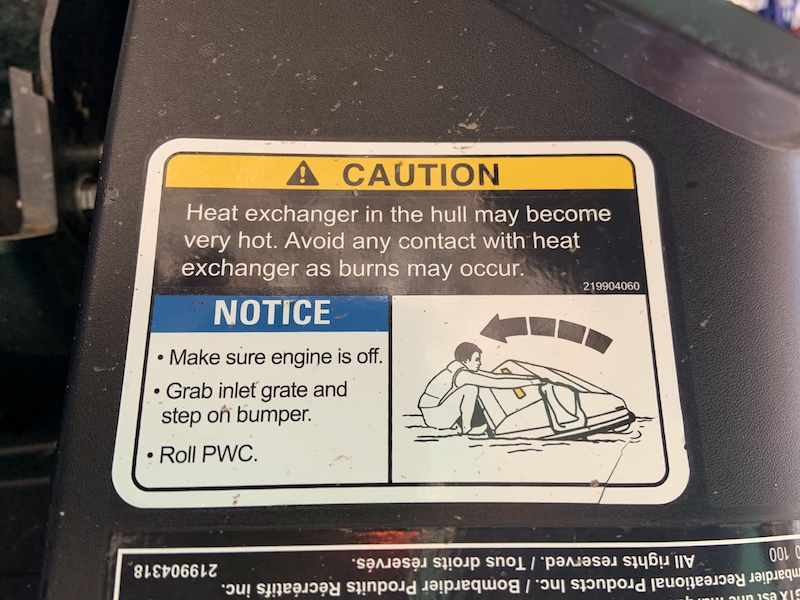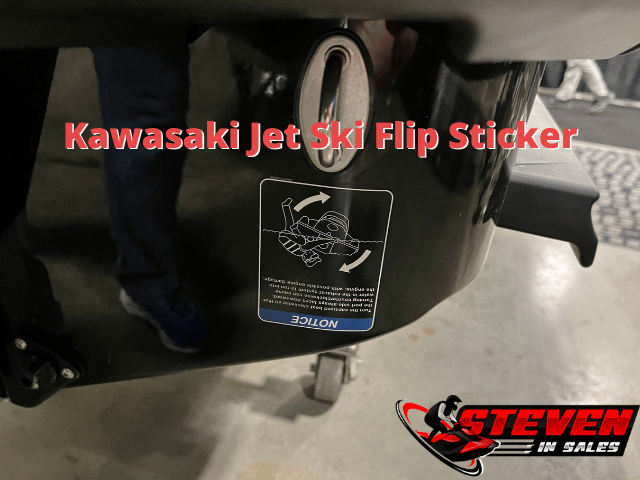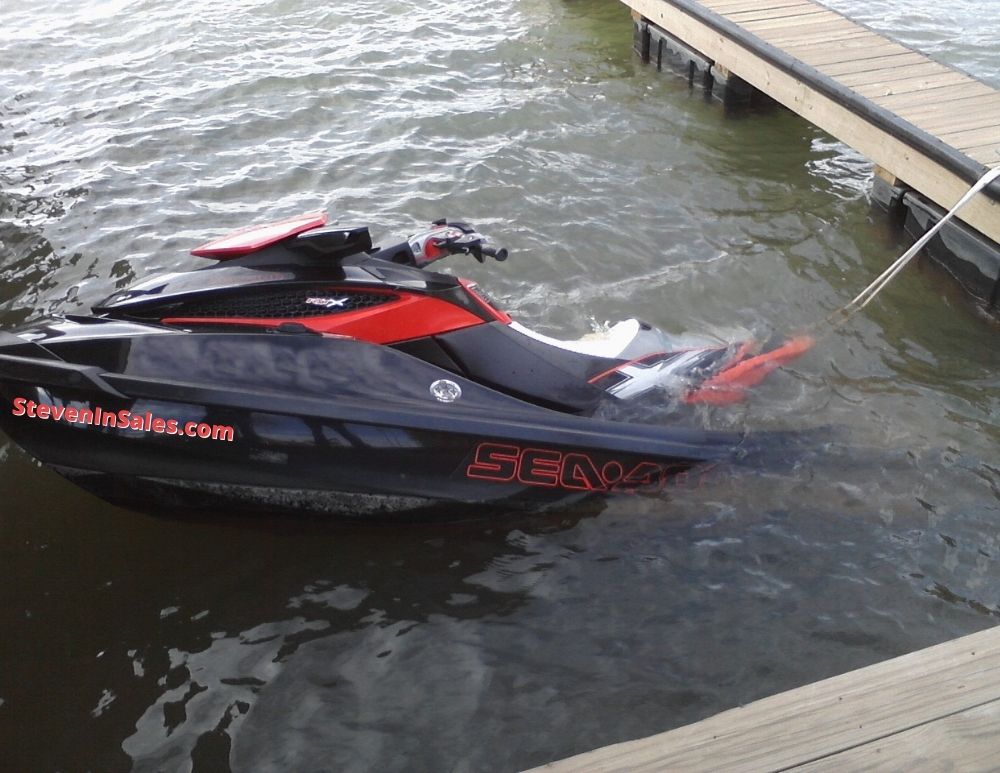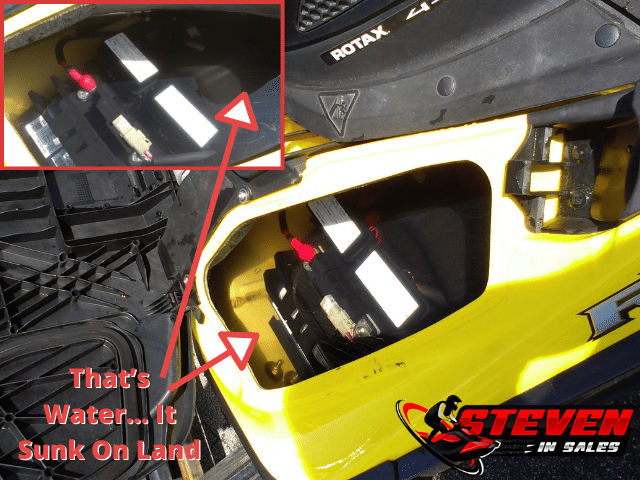Quick!
What do you do if your jet ski was flipped? I’ve listed the steps below. Let’s be quick about it, as time is critical!
What You Need To Do!
- If you flipped your jet, you need to turn the engine off right away!
- Go to the back of the watercraft to see the direction to roll it back over. It’s vital you follow the direction on the sticker.
- Quickly flip it over; the longer you wait, the more water will enter the hull.
- If the jet ski has been capsized for more than 5 minutes, DO NOT start the engine. At that point, assumed the engine has ingested water and now is “hydrolocked”; starting a hydrolocked engine will damage it.
- If it’s been flipped for less than 5 minutes, and it was flipped in the correct direction, attempt to start the engine. If the engine does not want to crank, do not attempt more tries; get towed to land. If the engine starts up fine, ride it like normal.
- As soon as you can, check for water in the hull and check the dipstick to make sure the oil does NOT look like chocolate milk. If water covers most of the engine, do not start the engine! If the oil looks like chocolate milk, then get it to the dealership as water is in the oil. Black or amber color is the thing you want for oil.


Max Upside-Down Limit For PWCs
When you flip a jet ski over, you want to flip it back over “the correct way” (The sticker in the rear tells you the direction to rotate) as soon as possible.
Water will start to enter into the engine compartment once it’s flipped, so make sure to get the PWC flipped back over before 30 seconds!
After 5 minutes
After 5 minutes with it upside down, I suggest you avoid starting the engine and assume the engine is damaged from being hydrolocked.
Why is water in the engine bad?
- Water doesn’t compress like air, and trying to start an engine with water in the cylinders will damage the engine. This is called a hydrolocked engine.
- Water, especially saltwater, is very corrosive, and the longer you keep water in the engine, the more difficult and expensive the repairs.
When it comes to saltwater, you want to get it out soon, within days if not the same day if you can. Lake and river water is more forgiving, but you should still be urgent!
Submerged, Do This:
- Drain water from the bilge when on land; remove the drain plugs.
- If a jet ski is submerged in salt water, rinse out the engine compartment with fresh water from a garden hose.
- Spray all unpainted metal and electrical components down with “anti-corrosion spray“.
- Pull the dipstick out and check the color of the oil. If the oil looks like “chocolate milk” or is extra runny, then water is in your engine, and the PWC needs to be taken in for repairs!
PWC Engine Took On Water
Do ---NOT--- start your jet ski if the engine has water in it!
You need to get the jet ski to your dealer or local repair shop, so they can remove the water. Time is essential, especially if you sunk it in saltwater!!!
Do not lie to the dealership; tell them the engine is hydrolocked, and they will know the steps to take.
The costs? Water damage in an engine can cost $500 to $3,000 to repair, potentially more for severe damage.
Flipping A Personal Watercraft Is Bad!
The reason why flipping a jet ski is bad is that the engine compartment is not sealed.
It can’t be, as air needs to get in somehow for the engine.
When it’s flipped over, the seats are underwater, and thus water will find its way into the engine compartment.
If water is getting into the engine compartment, then it’s a good chance it will get into the engine itself if there is enough water or if you upright the jet ski the wrong way.
The Damages You’ll Occur
On 4-stroke jet skis, you can break it and do damage to the engine if you flip it over the wrong way!
On the back, there is a sticker that tells you which way to flip it over to keep from damaging the engine. It’s very important you follow the direction of the sticker when rolling it back over, or you will damage the engine!
If you do flip the jet ski the wrong way, you can get it fixed, but it’s ideal you flip it the right way.
4-strokes Will Shut The Engine Off When Upside Down
4-stroke have a switch that kills the engine when it’s been flipped over.
2-stroke don’t always have a switch, so be careful! I’ve almost lost a finger when I flipped an old 2-stroke when I reached for the intake grate without realizing the engine was still on.
No matter the watercraft, make sure the engine is off before you go reaching to flip it over!
Pull the safety lanyard to make sure the engine is off, one end should be connected to you.




Great article Steven, and love to see updates to the website whenever you publish them. This article inspired some follow-up questions as I read it that didn’t get answered. If. you don’t mind, may I ask them here in the comments?
In the top section with 6 steps for “What should you do if you flip a jet ski?”
If it was flipped back over the correct way in less than five minutes, what would one do if the engine does start that one time you try to start it? Use as normal? Or, let idle for a good while, or treat gently for a while then use normally, or take to dock and remove from lake? Should you still take it in for service?
Thanks Steven, great article!
If flipped back over correctly and under 5 minutes and starts fine I would ride it like normal. Sometimes jet skis flip over, not as much as they used to, but when done correctly it’s no big deal. Here is a great video going through the motion of a flip over on a Sea-Doo Spark… https://www.youtube.com/watch?v=PcnmF3JnPN0
Thank you, great vids- watched them both. Trick is making certain you know which way YOUR ski gets turned to right it.